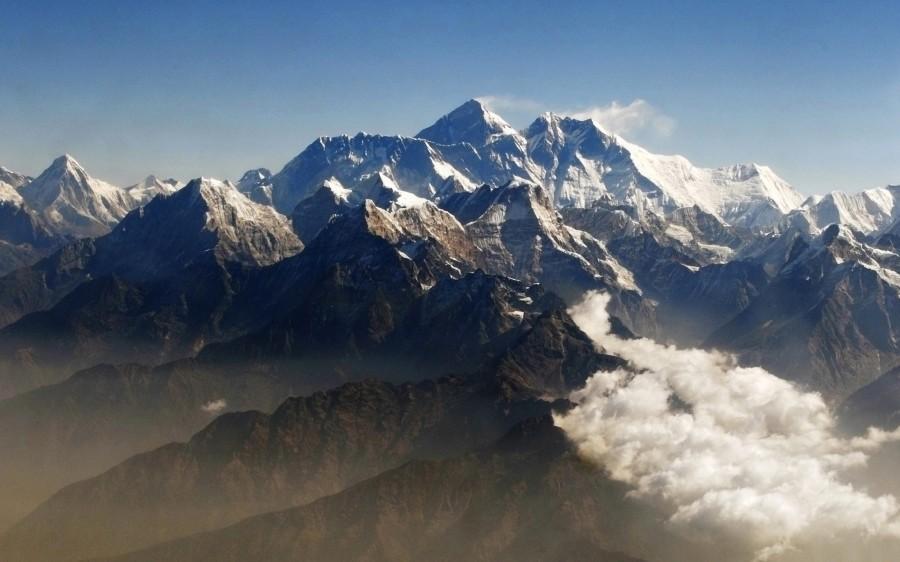Mountain vs. Man: Everest’s victorious history
In 1856 the world was made aware of the magnitude of the planet’s highest peak. Mount Everest was given this distinction by the Great Trigonometric Survey of India, and at 29,002 feet, Earth’s champion mountain posed a challenge that would prove more than humanity could handle.
Staggering over the rest of the Himalayan mountain range, Chomolungma, as it is called in Tibet; rests in a turbulent location; the International border of China and Nepal runs precisely across the summit point.
There are a total of 21 possible routes up the mountain; the standard and more heavily travelled routes are along the Southeast and Northeast ridges. Since the summit was first attempted in 1921, there have been over 3,500 individuals who successfully made the ascent to the peak. As of 2012 there were over 220 recorded fatalities, most of which took place before 1990. Changes in climbing equipment led to a sharp drop in fatalities in the 2000’s, with the death rate dropping from 37% in 1990 to about 4.4% in 2004.
Sir Edmund Hillary of New Zealand and Tenzing Norgay of Nepal are recognized today as the first men to reach the summit – in 1954 – but before these two pioneers even dreamed of the mountain, many tried; failed, and some perished in attempts to explore the unforgiving mountain.
George Mallory and Andrew Irvine were granted entrance to the mountain from Tibet, by the Dalai Lama in 1921 – and their British reconnaissance expedition climbed around the base of the mountain for five months in search of a feasible route up the North Col. of the mountain. After mapping and exploring the lower glaciers, George Mallory became the first man to set foot on the mountain, followed by two other men – before being forced down by strong winds.
One of the most enduring mysteries in the history of human exploration is whether or not Mallory and Irvine reached the summit 30 years before Hillary and Norgay did. The two men disappeared on an expedition in 1924 after leaving their base camp for the last time. From the weather data recorded at the time of the expedition attempt, experts conclude that the two climbers were enveloped in a blizzard that brought fatally low oxygen levels to their altitude.
Mallory and Irvine research expeditions have taken place since their disappearance on the mountain. Early on, in 1933, an ice axe was recovered that belonged to Andrew Irvine.
In 1999, The Mallory and Irvine Research Expedition launched an international team of elite climbers, informed by researchers; to hopefully locate Irvine’s body, a distance below where his ice axe was recovered.
Only hours after the search was launched, American rock climber and mountaineer Conrad Anker located a body. Largely to the researchers’ surprise, it was Mallory’s body that was found face down, frozen in time on the North Face, at 8,155 meters.
Mallory’s body lay face down, with arms outstretched as to break a sliding fall, with a broken leg. But fueling the long-living mystery is the absence of a photograph of Mallory’s beloved wife that he carried – and planned to place on the summit if they were successful.
Irvine was said to have had a camera, and the expedition hoped to locate Irvine to see if there was a photo of the men on the summit – proving they had made it. Irvine’s body remains lost to the mountain; and the mystery of the two explorers’ success may very well stay on Everest for the rest of time.
Today, the haunting majesty of Mt. Everest is clouded by the tragic commercialization of the 60 million year-old wonder of the Earth. The climbers who pioneered the first lonesome ascents of the mountain over 75 years ago would be appalled by the crowds that now are equipped and guided to the top.
In this modern century, a capitalistic empire thrives on the mammoth landscape of the Himalayas. Acting as if the majesty is theirs to tamper with; thousands of people flock to the base of the mountain and wait for their turn get their picture taken at the top.
The locals who work as Sherpa guides are simply continuing their part of the worlds’ tradition of mountaineering. The Mountains to the Sherpa people are formations of great respect and wonder – while westerners and other outsiders have poured into the region, infesting the area around Everest’s base camp and waiting pampered in a queue to pay their way to “achieve” the summit.
These ‘expedition’ tours include helpers and people to carry equipment, and even cooks. Members of a local ethnic group, called Sherpas, often work as guides or helpers. Climbers make their ascent and descent in steps, moving from camp to camp over the course of several days. Porters/Sherpas carry the bulk of the load up miles of hazardous trails; running the gauntlet through passes of deadly rockfall.
A lead mountain guide earns as much as $6,000 during the three-month climbing season. The monthly average salary of Nepalis is $48.
This past month, a massive avalanche killed 16 Nepali mountain guides, devastating not just the families of the men; but the whole mountaineering community and country as a whole.
The deadliest day on Everest to date has proven too impactful to ignore. Western minds can’t comprehend the fact that elsewhere in the world, people’s lives matter just as much as their own. The ideal that money determines a universal worth; or that because a human is born in a different part of the world that their life come’s second to one’s desire for glory.
The Sherpas have since halted their three month climbing season, calling this the “Black Year” of Everest. The families of the Sherpas who were killed now have no father, brother, or son to bring back to their village their pay.
Since the day of the avalanche, the well-trained and practiced Sherpas are calling off their climbing season to honor their fallen brothers, and protest the poor insurance and wages they receive.
Nepal’s government has not expressed a sense of urgency to help them, despite profiting from the climbing fees charged to many Everest expeditions. Earlier this year in February, the Ministry of Culture, Tourism and Civil Aviation announced that it was bringing down the price it charges to climb Mount Everest to $11,000 from $25,000 per climber. For many years, hopeful climbers were paying up to $50,000 to receive a permit for climbing Everest, but close to none of that trickled down to the hardworking guides.
The glory that people are able to pay for in this modern era of guided mountaineering may be off the market. This leaves the real adventurers to make the journey themselves. The tons of trash and countless bodies scattered about the mountain will remain to serve as a reminder of the fury of the Mother of the Earth – Mt. Everest.

I'm Chris Henkel, I'm a writer, and co-editor for Elder High School's school paper - both print and online. In general, I'm a guy that likes to be outside....













